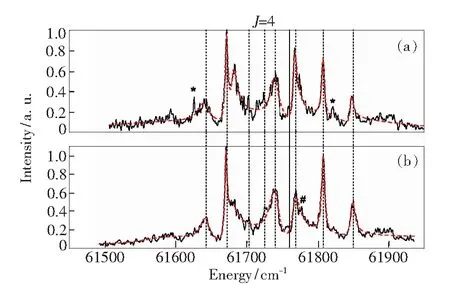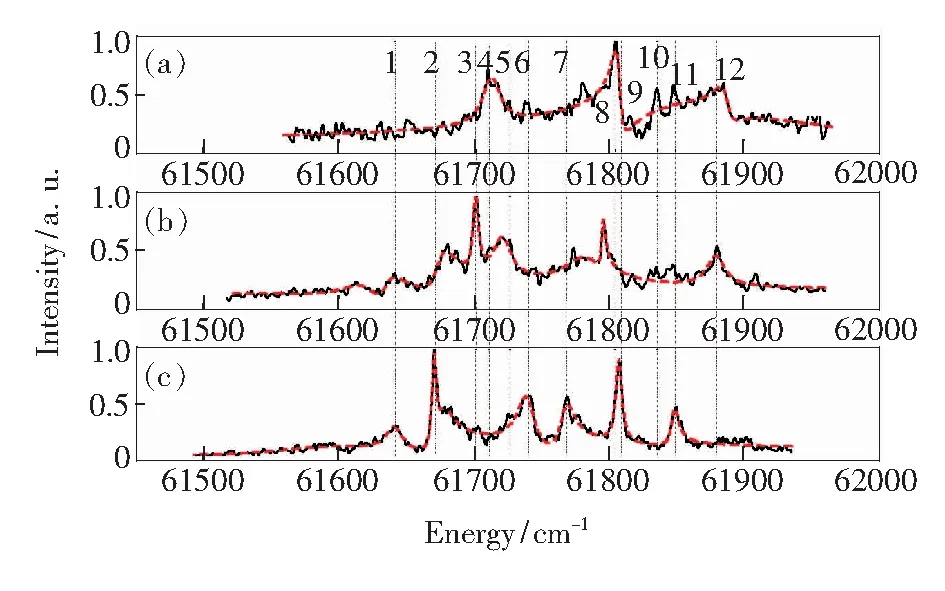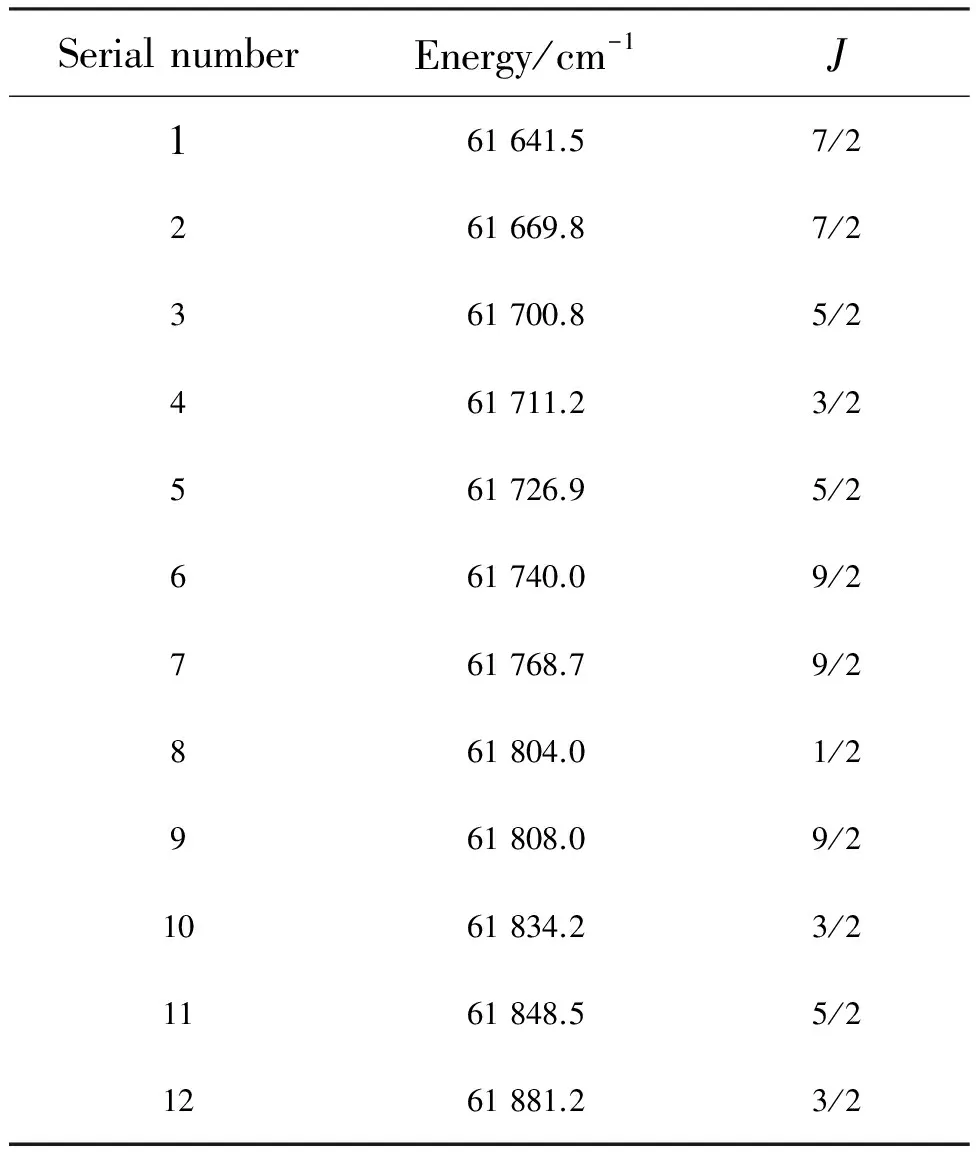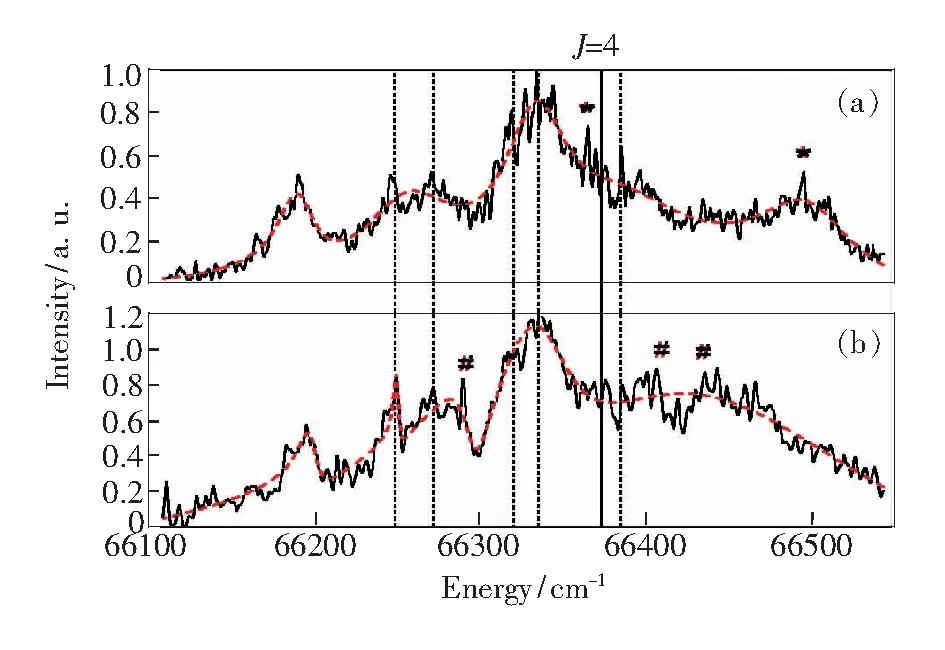Spectra of Eu 4f76p3/2 nd Autoionizing States
-, , -, -*
(1. School of Sciences, Tianjin University of Technology, Tianjin 300384, China;2. Key Laboratory of Display Materials and Photoelectric Devices, Ministry of Education, Tianjin University of Technology, Tianjin 300384, China)*Corresponding Author, E-mail: daicj@126.com
SpectraofEu4f76p3/2ndAutoionizingStates
CHANGXin-xin1,2,SHENLi1,2,YANGYu-na1,2,DAIChang-jian1,2*
(1.SchoolofSciences,TianjinUniversityofTechnology,Tianjin300384,China;2.KeyLaboratoryofDisplayMaterialsandPhotoelectricDevices,MinistryofEducation,TianjinUniversityofTechnology,Tianjin300384,China)*CorrespondingAuthor,E-mail:daicj@126.com
Experimental spectra of the Eu4f76p3/2nd(n=6,7) autoionizing states were investigated by using the three-step isolated-core excitation technique, while the impact of laser polarization on the spectra was studied for the first time. A detailed interpretation to the complex spectra of the4f76p3/2nd (n=6,7) autoionizing states is fulfilled by reproducing their line shapes with a multi-peaked fitting process. The spectroscopic information of the autoionizing states, like the total angular momentum (J), is deduced by comparing their corresponding spectra obtained under different excitation paths.
Eu atom; spectrum of autoionizing state; laser polarization; selection rules
1 Introduction
In the past several decades, the investigations of autoionization spectra[1-3]and dynamical process of autoionization[4]on several atoms have been performed extensively. More recently, the highly excited states of rare-earth atoms have also attracted considerable attention[5-7]. Among the rare-earth atoms, Yb atom has been mostly studied because of its simplest atomic structure that leads to basically an alkaline-earth-like spectrum. Eu atom, however, is a more challenging system because of its half-filled 4f shell and the highly complex nature of its spectrum[8-9]. Although there have already been some reports on the autoionizing states of Eu atom[10-13], they are limited to the converging to the lower ionic limits, such as the Eu 4f76p1/2nd autoionizing states, whereas Eu 4f76p3/2nd autoionizing states have remained untouched so far.
Since Eu 4f76p1/2nd and 4f76p3/2nd autoionizing states are the two different autoionizing series, and the average energy of the latter is 2 851.8 cm-1higher than that of the former, so the obvious physical differences are expected. Additionally, the wavelength of the third laser for the excitation of the 4f76p3/2nd autoionizing states has to be much shorter than that for the 4f76p1/2nd autoionizing states, which is quite close to the shortest wavelength limit of the laser dyes. Therefore, not only do the related physical problems become more challenging, but also the experimental difficulty is greatly increased. Apparently,such a study is necessary as Eu 4f76p3/2nd autoionization series in the higher energy region can be revealed, and the application of the isolated-core excitation (ICE) technique can be expanded to the newly-found autoionizing states. Furthermore, the impact of laser polarization on the autoionization spectra of Eu 4f76p3/2nd states will be explored, which has only been done in the alkaline-earth atoms[14-17]before. Finally, an assignment ofJvalues to all the peaks in the autoionization spectra will be carried out by comparing their corresponding spectra obtained under different excitation paths, which is also a task with both expected and unexpected challenges.
2 Experiments
The experimental setup used here is shown in Fig.1. It consists of three parts: a laser system, an Eu atomic beam preparation system and a data acquisition system. The three-step excitation in the experiment requires three pulsed dye lasers operated at 20 Hz, pumped by the 2nd or 3rd harmonic generation (at a wavelength of 532 or 355 nm) of the same pulsed Nd∶YAG laser. Note that the first dye laser is pumped by the 2nd harmonic generation, while the second and third dye lasers are pumped by the 3rd harmonic generation. Each dye laser has a typical output with a line width of 0.2 cm-1, pulse width of 5-8 ns and pulse energy of 0.5 mJ.

Fig.1 Schematic diagram of the experimental setup. P is a polarization controller that includes a half-wave plate and a polarizer.
The sample of Eu atom is produced in a vacuum chamber from a resistively heated oven, wherein the atomic vapor is collimated and directed to the interaction region. A pulsed electric field is applied to collect the ions from the autoionization process approximately 0.5 μs after the laser pulses.
To ensure the polarization purity of the laser, a polarization controller is inserted on their way into the vacuum chamber. The three laser beams propagate collinearly and cross the atomic beam perpendicularly in the interaction region in order to avoid the Doppler broadening effect.
The data acquisition system includes a micro-channel plate (MCP) detector and a Boxcar (model 4121B) triggered by a digital pulse generator (model 9650A), which are made by the AMETEC company. The ions, resulting from the excitation and subsequent decay of autoionizing states, are extracted with a pulsed electric field to the MCP detector, whose output is fed into the Boxcar and stored in a computer for further analysis.
To investigate the Eu 4f76p3/2nd autoionizing states, the three-step ICE technique[18]is employed.

Fig.2 ICE excitation scheme of Eu 4f76p3/2nd autoionizing states
The ICE scheme for Eu 4f76p3/2nd autoionizing states is shown in Fig.2.


Method A:





The ground state of the Eu atom, withJ=7/2 and 8 differentMvalues, makes the situation much more complicated. For reference, the ground states of all alkaline-earth atoms and the Yb atom have only one level withM=0 andJ=0. Obviously, the difference above will make the polarization influences on the spectrum in the Eu atom less apparent than those in the other two-electron atoms.
The total transition probabilityWfrom the ground state to the autoionizing stateviabound Rydberg states depends on the polarization of three lasers,JandMvalues of these relevant states. It is proportional to the sum of the square of the product of three Wigner 3j symbols, as follows:

(1)

3 Results and Discussion

W(J3=5/2)∶W(J3=7/2)∶W(J3=9/2)=
a∶b∶c,
(2)
Similarly,
a′∶b′∶c′,
(3)
wherea,b,c,a′,b′ andc′ represent constants proportional to the reduced matrix elements of the transition. The experimental spectra of Eu 4f76p3/2nd (n=6, 7) autoionizing states that are fitted with Fano line shape will be shown and analyzed.




Now let us turn toJvalue of the peaks, for it is another way to observe the impact of laser polarization on the spectra. Specifically, an effort is made to see whetherJvalues of the peaks in the spectra of the 4f76p3/26d autoionizing states can be identified with the different laser polarization combinations. To fulfill such an effort, the relative intensity of the two spectra obtained with Case 1 and Case 2 are evaluated according to Eq.(1). The analysis results for transition intensities for each possibleJ3value of 4f76p3/26d autoionizing states normalized to Case 1 are given in Tab.1.
Since the ICE technique is used in this experiment, the value ofJ3in the scheme Ⅲ can only be 5/2, 7/2 and 9/2, as shown in Tab.1. Besides, the transition intensities for most ofJ3in the Case 1 are smaller than those in the Case 2.


CaseNormalizedtransitionintensityJ3=5/2J3=7/2J3=9/21abc21.12a1.53b0.46c
On the other hand, the same ratios can be evaluated from the spectra of the 4f76p3/26d autoionizing states shown in Fig. 3, and the results of which are shown in Tab.2.
Tab.2PeakratiosofthetwocasesforallpeaksinFig.3

PeaknumberEnergy/cm-1Intensityratio161642.90.86261671.10.98361700.80.84461726.91.12561740.00.97661768.70.74761808.01.29861848.51.40
As shown in Tab.2, most of the ratios are slightly less than those listed in Tab.1. The experimental results do not agree well with the theoretical values, which manifests that the polarization influences on Eu autoionization spectra show less apparent, leading thatJvalues of Eu 4f76p3/26d autoionizing states are not easy to identify with different laser polarization combinations. As the peaks converging to other ion limits appear in the 4f76p3/26d spectra, which manifests that the intensity of the spectra converges to the 4f76p3/26d are affected, leading that the peak ratios of the two cases are affected. The values of some peaks can be estimated by using this method, but it can only get a small part of the correctJvalue, so the method does not apply to complex atoms.
Based on the above fact thatJvalues of Eu autoionizing states are not easy to identify with different laser polarization combinations, the spectra of three schemes in method A are shown in Fig.4, which cover the same energy region.
As shown in Fig.4, the spectra of Eu 4f76p3/26d autoionizing states are all superimposed with some narrow peaks, which are identified as the autoionizing states with higher-nvalues converging to the lower ionization limits. Based onJselection rules corresponding to the three excitation schemes described in method A, one may makes some comparisons with these spectra in order to assignJvalues of some peaks in Fig. 4, which are shown in Tab.3.

Fig.4 Experimental spectra of Eu 4f76p3/26d autoionizing states obtained in method A. (a) Eu 4f76p3/26d [J=1/2, 3/2 or 5/2] spectra. (b) Eu 4f76p3/26d [J=3/2, 5/2 or 7/2] spectra. (c) Eu 4f76p3/26d [J=5/2, 7/2 or 9/2] spectra.

Tab.3 Energies and J assignments of the peaks
As shown in Tab.3, the uniqueJvalues are assigned to many peaks, respectively. A similar measurement and analysis for Eu 4f76p3/27d state is shown below.



Some peaks only exist in Fig.3(a)(marked with sign “*”), or some only show in Fig.3(b)(marked with sign “#”). The autoionization peak position has a shift to the ionization limit, that is because the quantum defect of the initial state of Eu 4f76s7d is different from the final state of Eu 4f76p3/27d.
Now let us turn toJvalue of the peaks, which is described in method B. The results for transition intensities for each possibleJ3value of 4f76p3/27d autoionizing states normalized to Case 1 are given in Tab.4.
Tab.4TransitionintensitiesforeachpossibleJ3valueof4f76p3/27dautoionizingstatesnormalizedtoCase1

CaseNormalizedtransitionintensityJ′3=7/2J′3=9/2J′3=11/21′a′b′c′2′0.26a′1.29b′2.5c′

Tab.5PeakratiosofthetwocasesforallpeaksinFig.5

PeaknumberEnergy/cm-1Intensityratio166249.61.7266270.41.25366321.21.02466335.11.01566397.81.30
As shown in Tab.5, most of the ratios are slightly less than those listed in Tab.4. Based on the above fact thatJvalues of some peaks can be estimated, but they can not be determined, the spectra obtained with the three schemes(which are similar to the method A) are shown in Fig.6, which cover the same energy region.

Fig.6 Experimental spectra of Eu 4f76p3/27d autoionizing states obtained with Scheme Ⅱ. (a) 4f76p3/26d [J=3/2, 5/2 or 7/2] spectra. (b) 4f76p3/26d [J=5/2,7/2 or 9/2] spectra. (c) 4f76p3/26d [J=7/2, 9/2 or 11/2] spectra.
As shown in Fig.6, the spectra of Eu 4f76p3/27d autoionizing states are also superimposed with some narrow peaks, which are some autoionizing states with higher-nvalues, converging to the lower ionization limits. Based on theJselection rules of the excitation schemes(which are similar to method A), theJvalues of some peaks can be assigned.
As shown in Tab.6,Jvalues of the peaks in Fig.6 can be identified uniquely by basing onJselection rules of the three excitation schemes(which are similar to method A).

Tab.6 Energies and J assignments of the peaks
4 Conclusion
In conclusion, the spectra of Eu 4f76p3/2nd (n=6, 7) autoionizing states have been investigated with the ICE technique through the two laser polarization combinations (πππ, σσσ). Although the effects of laser polarization are observed from Eu 4f76p3/2nd (n=6, 7) autoionization spectra, it is not sufficient to assignJvalue to the peaks in the spectra, as the heavy configuration interaction among different autoionizing series make Eu 4f76p3/2nd (n=6, 7) autoionization spectra much more complicated than their counterparts of Yb atom. On the other hand,Jvalues of some peaks can be assigned uniquely by comparing the different spectra obtained with the three excitation schemes. Furthermore, the study on autoionization spectra of Eu 4f76p3/2nd (n=6, 7) autoionizing states shows that the ICE method is almost invalid for such lownvalues.
[1] JONES R R, DAI C J, GALLAGHER T F. Ba 6pjnfjprime autoionizing series [J].Phys.Rev. A, 1990, 41(1):316-326.
[2] SCHINN G W, DAI C J, GALLAGHER T F. Mg 3pns and 3pnd (J=1) autoionizing series [J].Phys.Rev. A, 1991, 43(5):2316.
[3] PASPALAKIS E, KYLSTRA N J, KNIGHT P L. Propagation dynamics in an autoionization medium [J].Phys.Rev. A, 1999, 60(1):642-647.
[4] LYRAS A, BACHAU H. Multiple phase control in Mg through the continuum [J].Phys.Rev. A, 1999, 60(60):4781-4787.
[5] LIANG H R, SHEN L, JING H,etal.. The VMI study on branching ratio decay from Eu 6p1/28s autoionizing state [J].Physics, 2014, 63(13):133202-133237.
[6] DAI C J. Angular distributions of electrons following photoionization of spherically symmetric Rydberg states in alkaline-earth atoms [J].Phys.Rev. A, 1996, 53(5):3237-3242.
[7] LÜ J, DAI C J, XU Y F,etal.. Electron branching ratios following autoionization of the Ba 6pns states [J].Chin.Phys.Lett., 2001, 18(4):516.
[8] LI S B, DAI C J, SUN W,etal.. The 6p3/2ns(J=1,2) autoionizing states of barium [J].J.Phys. B, 2001, 34(34):2123.
[9] ZHANG Y, DAI C J, LI S B,etal.. The spectroscopic properties of Ba 6p3/2nd (J=1,3) autoionizing states [J].J.ElectronSpectrosc.Relat.Phenom., 2004, 135(1):63-71.
[10] WU X R, SHEN L, ZHANG K,etal.. Branching ratio and angular distribution of ejected electrons from Eu 4f76p1/2nd auto-ionizing states [J].Chin.Phys. B, 2016, 25(9):093203.
[11] ZHANG K, SHEN L, DONG C,etal.. The VMI study on angular distribution of ejected electrons from Eu 4f76p1/26d autoionizing states [J].Chin.Phys. B, 2015, 24(10):103204.
[12] YAN J G, SHEN L, LIANG H R,etal.. Branching ratios of autoionization from Eu 4f76p1/26d [J] autoionizing states [J].Chin.Phys. B, 2015, 24(8):296-301.
[13] 李琼, 沈礼, 闫俊刚,等. Eu原子4f76p1/2ns自电离过程的动力学特性 [J]. 物理学报, 2016, 65(15):153202.
LI Q, SHEN L, YAN J G,etal.. Dynamic properties of Eu 4f76p1/2ns autoionization process [J].ActaPhys.Sinica, 2016, 65(15):153202. (in Chinese)
[14] COOKE W E, GALLAGHER T F, EDELSTEIN S A,etal.. Doubly excited autoionizing Rydberg states of Sr [J].Phys.Rev.Lett., 1978, 40(3):178.
[15] KACHRU R, VAN DEN HEUVELL H B L, GALLAGHER T F. Resolution of the Ba (6pjndj)1and (6pjndj)3autoionizing states and their mixing with the (6pjns1/2)1and (6pjngj)3states [J].Phys.Rev. A, 1985, 31(2):700.
[16] COHEN S, AYMAR M, BOLOVINOS A,etal.. Experimental and theoretical analysis of the 5pnpJ=0, 1, 2 autoionizing spectrum of Sr [J].Eur.Phys.J. D, 2001, 13(2):165-180.
[17] LI SSHIBEN, DAI C J, SUN W,etal.. Study of Ba 6p1/2ns (J=0,1) autoionizing series [J].J.ElectronSpectrosc.Relat.Phenom., 2002, 127(3):183-195.
[18] DAI C J, SCHINN G W, GALLAGHER T F. Mg 3pnd(J=3) autoionization spectra using isolated-core excitation [J].Phys.Rev. A, 1990, 42(42):223-235.

常鑫鑫(1992-),男,山西长治人,硕士研究生,2014年于长治学院获得学士学位,主要从事稀土原子高激发态方面的研究。

E-mail: sjx1054419689@163.com戴长建(1957-),男,山东青岛人,教授,博士生导师,1992年在University of Virginia获得硕士学位,主要从事原子与分子物理和光谱学以及高灵敏探测技术方面的研究。
E-mail: daicj@126.com
铕原子4f76p3/2nd自电离态的光谱
常鑫鑫1,2, 沈 礼1,2, 杨玉娜1,2, 戴长建1,2*
(1. 天津理工大学 理学院, 天津 300384;2. 天津理工大学 显示技术与光电器件教育部重点实验室, 天津 300384)
利用三步三色孤立实激发技术(ICE),系统地研究了铕原子4f76p3/2nd自电离态的光谱,同时首次研究了激光偏振对复杂原子的光谱的影响。为了研究铕原子4f76p3/2nd自电离态的光谱,首先设计并采用了不同的激发路径,分别将原子布居到同一高激发能域并探测它们在该能域的自电离光谱。通过比较这些光谱的异同并结合上述激发路径所对应的跃迁选择定则,便可唯一地确定这些高激发态的总角动量。为了研究激光偏振对铕原子的影响,设计并使用了两种偏振组合:三步激光都是垂直(πππ),三步激光都是平行(σσσ)(激光偏振方向相对于探测器垂直或平行)。为了得到有偏振影响的光谱,分别使3部激光器处于同一偏振,依次对铕原子进行激发,激发路径与终态同上。通过对同一路径不同偏振下的光谱的比较,发现仅能确定极少数的高激发态的总角动量,同时在光谱中一些峰独立于另一偏振光谱存在。
铕原子; 自电离光谱; 激光偏振; 选择定则
2017-04-21;
2017-05-19
国家自然科学基金(11174218) 资助项目
O562.3+1; O433.5+9DocumentcodeA
10.3788/fgxb20173811.1461
Supported by National Natural Science Foundation of China(11174218)

